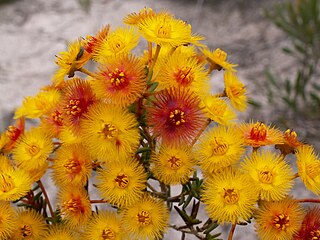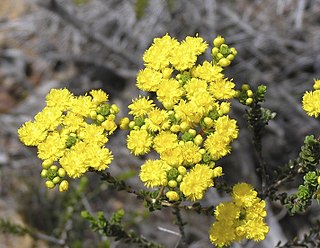
Verticordia aereiflora is a species of flowering plant in the myrtle family, Myrtaceae and is endemic to the south-west of Western Australia. It is a thin but bushy shrub with small leaves and greenish-yellow flowers with red spots and red fringes on the sepals.

Verticordia capillaris is a species of flowering plant in the myrtle family, Myrtaceae and is endemic to the south-west of Western Australia. It is a shrub with a single stem at the base, small leaves and creamy white or occasionally pink flowers in dense corymb-like groups. It is common in small areas near Geraldton.

Verticordia galeata is a flowering plant in the myrtle family, Myrtaceae and is endemic to the south-west of Western Australia. It is a woody shrub with thin, pointed cylinder-shaped leaves and heads of bright yellow flowers on the ends of the branches in spring.

Verticordia chrysostachys is a species of flowering plant in the myrtle family, Myrtaceae and is endemic to the south-west of Western Australia. It is an open-branched shrub with egg-shaped to almost circular leaves, and spike-like groups of cream-coloured or deep yellow flowers.

Verticordia densiflora, commonly known as compacted featherflower, is a flowering plant in the myrtle family, Myrtaceae and is endemic to the south-west of Western Australia. It is a shrub with small leaves, usually small pink and white flowers and which is widespread in the south-west of the state. It is a variable species and in his 1991 paper, Alex George formally described five varieties.

Verticordia endlicheriana is a flowering plant in the myrtle family, Myrtaceae and is endemic to the south-west of Western Australia. It is a shrub with narrow leaves and yellow flowers which in some varieties age to red. It is a variable species and in his 1991 paper, Alex George formally described five varieties.
Verticordia endlicheriana var. endlicherliana is a flowering plant in the myrtle family, Myrtaceae and is endemic to the south-west of Western Australia. It is a small, compact shrub with mostly narrow leaves and golden-yellow flowers which age to reddish brown.
Verticordia endlicheriana var. angustifolia is a flowering plant in the myrtle family, Myrtaceae and is endemic to the south-west of Western Australia. It is a small, upright shrub with narrow leaves and sweetly-perfumed, golden-yellow flowers which do not change colour as they age.
Verticordia endlicheriana var. major is a flowering plant in the myrtle family, Myrtaceae and is endemic to the south-west of Western Australia. It is a small, compact shrub with lightly-scented, lemon-yellow flowers which do not change colour as they age.

Verticordia etheliana is a flowering plant in the myrtle family, Myrtaceae and is endemic to the south-west of Western Australia. It is a shrub with one highly branched main stem, egg-shaped to almost round leaves and spike-like groups of bright red flowers with greenish-cream centres.
Verticordia etheliana var. etheliana is a flowering plant in the myrtle family, Myrtaceae and is endemic to the south-west of Western Australia. It is a shrub with one highly branched main stem, egg-shaped to almost round leaves and spike-like groups of bright red flowers with greenish-cream centres. It differs from V. etheliana var. formosa in having longer leaves, and larger flowers.
Verticordia etheliana var. formosa is a flowering plant in the myrtle family, Myrtaceae and is endemic to the south-west of Western Australia. It is a compact shrub similar to var. etheliana but with smaller leaves and flowers.

Verticordia huegelii var. decumbens, commonly known as variegated featherflower, is a flowering plant in the myrtle family, Myrtaceae and is endemic to the south-west of Western Australia. It is an almost prostrate shrub, with creamish-lemon coloured flowers turning pink then red as they age, giving the plant a variegated appearance. It is similar to Verticordia huegelii var. huegelii but has a lignotuber and a lower growth habit.
Verticordia huegelii var. stylosa, commonly known as variegated featherflower, is a flowering plant in the myrtle family, Myrtaceae and is endemic to the south-west of Western Australia. It is a single-stemmed shrub with its growth form depending on its surroundings. It is similar to other varieties of the species but differs in its flower colour and the form of the style and staminodes.
Verticordia huegelii var. tridens, commonly known as variegated featherflower, is a flowering plant in the myrtle family, Myrtaceae and is endemic to the south-west of Western Australia. It is a slender, open, sometimes straggly shrub with bright yellow flowers which age to red and then brown and differently-shaped staminodes from the other varieties of the species.

Verticordia lepidophylla is a species of flowering plant in the myrtle family, Myrtaceae and is endemic to the south-west of Western Australia. It is usually a bushy shrub with small leaves and spikes of creamish-green to yellow flowers in spikes along the branches in late spring to early summer.
Verticordia serotina is a flowering plant in the myrtle family, Myrtaceae and is endemic to the north-west of Western Australia. It is a shrub with egg-shaped leaves and bright pink flowers with long, curved styles in spring.

Verticordia serrata is a flowering plant in the myrtle family, Myrtaceae and is endemic to the south-west of Western Australia. It is a spindly or openly branched shrub with hairy, egg-shaped leaves and flowers which are golden at first, then fade to a greyish colour.
Verticordia sieberi is a flowering plant in the myrtle family, Myrtaceae and is endemic to the south-west of Western Australia. It is a shrub with one main stem, often compact but sometimes openly branched and with pink to pale purple flowers in summer and autumn.

Verticordia × eurardyensis, commonly known as Eurardy magenta, is a species of flowering plant in the myrtle family, Myrtaceae and is endemic to a small area in the south-west of Western Australia. It is a shrub similar to both Verticordia dichroma and Verticordia spicata which grow in the same area and is thought to be a stable hybrid between those two species. It has mostly egg-shaped leaves and spike-like groups of dark magenta-coloured flowers which fade to straw-coloured, in late spring and early summer.












